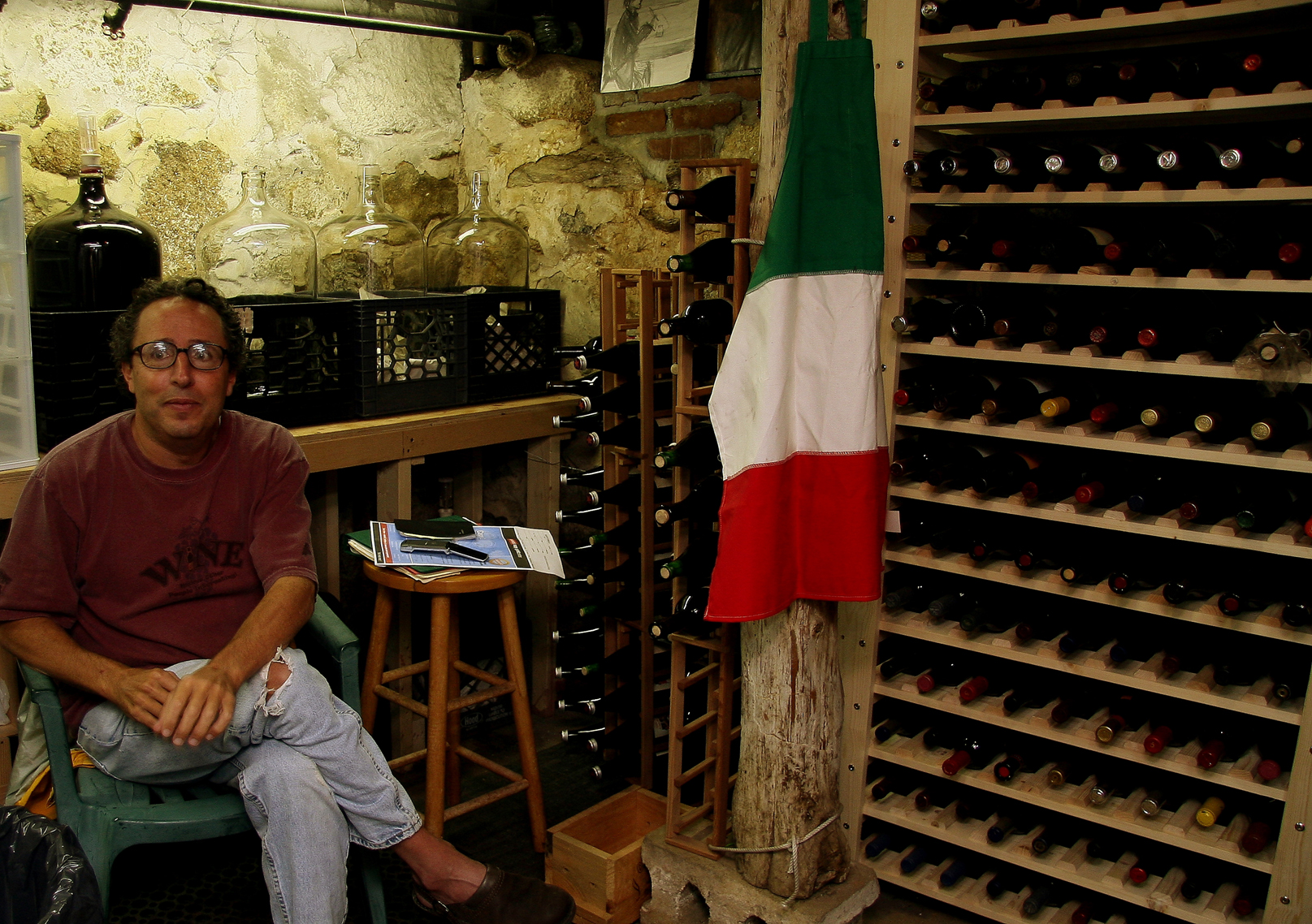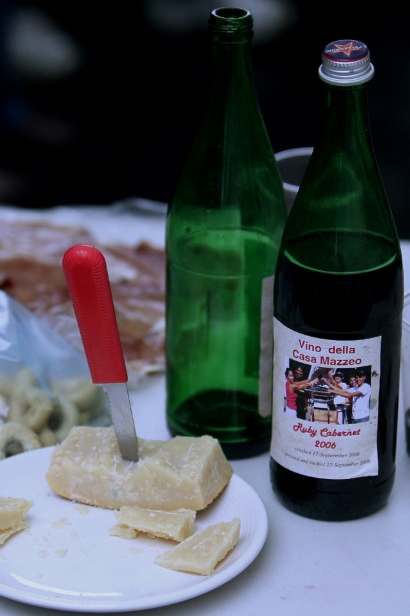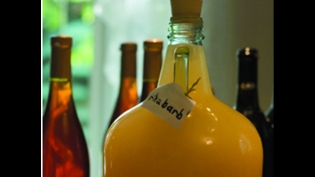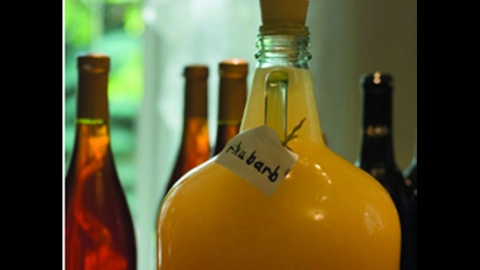The Vines That Bind
The message from the Edible Cape Cod office went something like this, “Paul Mazzeo of Palio Pizzeria is making his wine again. If you want to see the process, get to Kandy Korner on Main Street in Hyannis. Be there Saturday at 10:00 a.m.”
Now who could refuse an invitation like that? Paul—whom I had met briefly only once before—was making wine…at a candy store…on a Saturday morning??? The cryptic invitation held enormous intrigue, and enjoying the tone of espionage, I responded with something to the affect of “The red raven flies at dawn,” which I assumed they understood as “I’ll be there.”
Arriving at Kandy Korner on a rainy September morning, I was escorted to the side alley and down a steep wooden staircase leading into a Cape Cod cellar, where Paul Mazzeo was holding court—albeit in a tiny, musty, stone-walled court. He introduced his two cousins Bob and Pat, who had driven over from Monroe, Connecticut to witness Paul’s once-a-year tradition. Fellow cellar dwellers Dianne and Doug Langeland from Edible Cape Cod were also present with camera in hand. Paul announced that it would be about an hour until his brother, Robert, arrived with the goods: 720 pounds of juicy, sun-kissed Cabernet Sauvignon grapes from Lodi, California. Robert had picked them up from the shipping destination, not far from his home in Easton, Connecticut. I was pleased to hear there would be a wait, as I still was not exactly sure why we were in a cellar…under a candy store…on a Saturday morning, but it gave me time to get to know the “man behind the cask”.
In spite of his modest interjections like “I hope I’m not boring you,” Paul’s career time line is an interesting one. Here’s a guy that arrived from Bridgeport, Connecticut in 1978 and bought a candy store on Cape Cod simply because, as he explains, “I worked at a Friendly’s restaurant, observed how a business is run and I liked working with people.” When asked about the inception of his highly respected Palio Pizzeria across the street in 2005, his answer is just as unaffected, “I make a great pizza—and the area needed a great pizza.”
The keys to Paul’s successes are as straight forward as his reasoning. One key is quality control. His ice cream and fudge, which are made in house, as well as the pizza ingredients at Palio, are made from high quality ingredients. “When a purveyor wants to sell me a product because it’s cheaper and can increase my profit margin I just want to…” He stops, and is obviously a bit annoyed by this concept. “Well I just want to tell them this!” (I won’t mention what hand gesture Paul makes, but we’ve all seen it before…and know what it means.) The other key to success is to not get too comfortable—keep things fresh, and keep people interested. Recent examples involve the future plans for cheese making classes at the restaurant, as well as the recently launched “Palio pizza dough-to-go”—a way for customers to pick up the raw key ingredient to one of the Cape’s best pizzas. Take home a large or small size pizza dough, roll it out, slap on some sauce, load on the cheese and fuhgeddaboudit you’ve turned your kitchen into a pizza parlor. With pizza dough-to-go the possibilities are endless…freeze the dough for a rainy day, host a build-your-own-pizza party, wow your buddies with oven fresh pizza for the Pat’s game, and, forget about oysters guys—you make her oven fresh pizza? And sprinkle on her favorite toppings??? Now that’s an aphrodisiac!
Eventually the conversation turned from dough (and aphrodisiacs), to wine making.
In keeping with his business approach of I want to do it, so I’ll do it, Paul wanted to create wine like his Italian ancestors did and not from a kit bought online. He looked to his friend Eddie Giavannone, who learned the trade from his father, Tony. Both Tony and Eddie took Paul under their wings and taught him the proper way to make wine, the way Tony’s father and grandfather taught him.
As Paul begins describing the process of wine making, the squeal of pickup truck brakes echo above us in the driveway. The grapes have arrived and the hands-on part of our lesson is about to begin!
Climbing to the top of the steep staircase we find ourselves under a worn out and frayed pop-up tent, which wasn’t there when we arrived—obviously Paul’s soldiers had been busy setting up camp while we were chatting below. Paul’s long-time friend (fellow Friendly’s alum and owner of Cook’s Seafood) Frank Whelan seems to know the drill and has everything needed to crush grapes underneath the dripping tent. Brother Robert is there, as are friends Paulo and Thiago who arrive to help (note: the next time you are leaving Kandy Korner with fresh ice cream and delicious homemade fudge smeared all over your face, thank Paulo—he’s the guy in the window making it). Before we begin, Paul takes a vine from the crate and offers us a taste. The Lodi region boasts itself to be the “Zinfandel capital of the world”, but the Cabernet grapes we sample are exquisite. We are told that these 720 pounds of grapes will yield about 56 gallons of wine—or as Paul affectionately calls it “Vino Della Casa Mazzeo”.
One by one, crates are carefully turned over into a contraption to be juiced, and I am charmed by the simplicity of the science of wine making.
“What do you call the thing that crushes the grapes?” I ask Paul.
“It’s called a crusher.”
“What do you call the thing under it that separates the stems?”
“That’s a de-stemmer.”
I didn’t have to ask what the juice and grape skins were collecting in. I knew the answer…a garbage can.
As the first crate of grapes are split open and the sweet smell of fruit permeates the chilly air, Jeff Anderson of The Wine List in Hyannis trots down the driveway (this was predictable—sniffing out grapes is Jeff’s sixth sense). As the grapes continue to be dropped into the crusher—which doesn’t so much “crush” them as splits them open—someone takes a spin at turning the crank, while another pushes the grapes down towards the crushing mechanism. This is done by use of yet another sophisticated wine making piece of paraphernalia called a 2 x 4.
The juice is then poured into a fermenting barrel in the cellar, along with the skins and 25 percent of the vines, which increase the tannins in the wine. Heaters are set up in the cellar to ensure the proper temperature—between 70 and 85 degrees Fahrenheit—and the wine will now be left to ferment (the technicalities of this is explained to me later in the week…painfully).
As the last drop of juice is poured in, Paul set up an impromptu celebration: a table of hot pizzas, gourmet olives, cheese and San Daniella Prosciutto. Accompanying our back alley banquet were a couple of bottles of his latest Vino Della Casa Mazzeo.
At first sip it’s obvious that this wine is bold…very bold. Much heartier and complex than your usual homemade vino (which can be overly fruity) and the tannins are balanced nicely. Not withstanding back alleys, basements, garbage cans and a basically airy approach to wine making, the final product is complex and delicious. The company is terrific as well, and we all enjoyed entertaining stories and some laughter. I returned home with a bottle of 2003 vintage, and when this special bottle is eventually uncorked, I hope that Paul is at my table (Paul if you’re reading this, that’s an invitation).
A few days later I’m invited back to “hear” the fermentation process. “The crackle and pop coming out of the barrel is terrific,” Paul explains, “It’s like having children in the house!” When I arrived, I was led back to the cellar by Paul’s long-time manager, Nancy Magnuson. The sweet smells of the grapes and strong scent of alcohol met us at the top of the stairs. We descended and opened the top of the barrel. You could hear the fermentation, but at this stage the sound was soft and dulcet—like the sound of simmering rice.
A couple of weeks later I returned once again for the pressing of the grapes. Newly familiar faces huddled around the grape press (another highly technical name), but now there were two new guys chipping in—Paul’s mentors, Eddie and Tony.
Now understand, the act of pressing grapes holds all of the excitement of being a rower at the bottom of a Viking ship. You grab the press handle and walk around…and around…and around the press until every last remaining drop of juice is salvaged and added to the barrel. Tony is extremely knowledgeable, and while pressing, explains the science behind fermentation, with things having to do with malolactic fermentation and malic and lactic acid conversion (getting a grade D- in chemistry I then decided the details should end with the 2 x 4). But a lot more is learned, more interesting stories are shared and more friends are made in an alley, by a candy store, off of Main Street.
It’s true what oenophile Ralph Steadman wrote in his book The Grapes of Ralph, “Nice people make great wines.”
It has been said that the best things in life are worth the wait, but sometimes it’s the wait that can be the best part of life (it’s why the gods created tailgate parties).
The pizzeria’s namesake, Il Palio, is a horse race held twice every year in Siena, Italy. Preparations for the race go on all year and 25,000 people attend and dine outside at enormous banquet tables. There are horse blessings, parades and celebrations for days on end. And how long does the race last, about a minute and a half.
It finally dawned on me why I was in a cellar…under a candy store…on that Saturday morning. It’s the same reason why people plan a year in advance for a one-minute horse race. And why the Mazzeos and the Giavannones take the time to do wine right. It’s not as much about the horse that wins the race, or the wine that ends up in the bottle. It’s about community. The horse race ends in the blink of an eye, just as the wine bottle gets emptied in a sitting. But the cultivation of friendships and good times shared during the process can forever simmer in your memory—like the soft sound of fermenting grapes.








